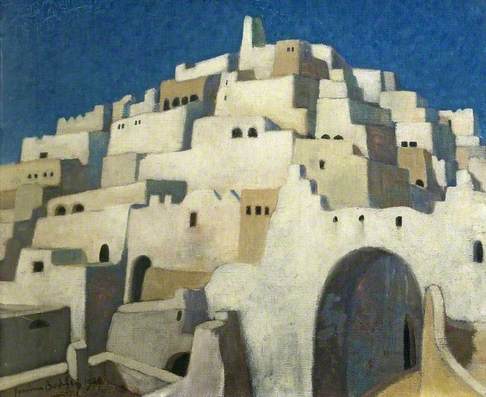
When walking through the permanent galleries between the more familiar Arts and Crafts and Edward Wilson and Cheltenham local history, my eye is often drawn to a smallish (37 cm x 45 cm) 20th Century oil painting in Gallery 8. The label merely says Josselin Bodley (1893-1974) A City on a Hill 1968. The architecture looks North African. The mood is tranquil but slightly sombre and unsettling. There are no people; nothing living. The style seems to owe something to cubism. I was intrigued to find out more about the artist (of whom I had never previously heard) and his work.
The artist was born into a patrician family – one of his ancestors was the sixteenth century founder of Oxford’s Bodleain Library, Sir Thomas Bodley – and was the second son of John Edward Courtney Bodley. His father, a college and masonic friend of Oscar Wilde’s at Balliol, worked first as secretary to the Liberal Minister Sir Charles Dilke but gradually emerged as the period’s most important English historian of France. Through his father’s wide circle of influential contacts and those of his brother Ronald and his sister Ava, Bodley was linked to some of the most important political and cultural figures of his generation. Ronald became a noted Arabist – recording his time amongst the tribesmen of North Africa in a life that reads somewhat like that of T. E. Lawrence in the Middle East – and Ava was married first to the diplomat Ralph Wigram and then to John Anderson, Churchill’s Home Secretary and Chancellor of the Exchequer during WWII.
Much of the artist’s early life was spent in France with his father, visiting the great and the good and unconsciously absorbing the atmosphere of the architectural riches of the French countryside. School at Eton followed this privileged but nomadic boyhood, after which Bodley left England for a garret flat in Paris, intent on a career as an artist – though such hopes were postponed by the outbreak of WWI.
Enlisting first as a Second Lieutenant in The King’s Royal Rifle Corps he remained militarily active throughout much of WWI – despite being wounded at Ypres in 1915 – leaving the army in 1919 with a Military Cross and the rank of Captain. His earliest surviving paintings date from this period and their atmospheric subject matter of ruined buildings and blasted leafless trees on the frontline prefigure much of the still, melancholic resonance of his finest mature work (see Shelley Farm, St. Eloi and Polygon Wood, Ypres at BBC Your Paintings / Josselin Bodley). Later in life he also received one of France’s highest civilian honours – for artistic achievements and cultural activities – becoming a Chevalier of the Legion d’Honneur.
Perhaps because he was not prolific and his paintings surface only rarely, Bodley’s achievements are now largely overlooked. However, in the inter-war period, he was considered amongst the most promising artists of his generation. Three times in the 1930s, he exhibited alongside Henry Moore. His paintings were purchased by museums across Europe and the USA. In the words of The Times art critic (4 November, 1933), his paintings offer a ”character that is very pleasing [and are] markedly linear in composition, sharply drawn, and executed in pale colours of great delicacy.”
A City on a Hill was painted in 1928. The 1968 date is when the Cheltenham Art Gallery and Museum acquired it as a gift from the Contemporary Art Society via the Tate Gallery. It may have been painted in Algeria where Bodley went to stay with his brother, Ronald.
Martin Renshaw
To see more artworks from The Wilson collection go to the Art UK website (click here) or The Wilson’s website (click here).
